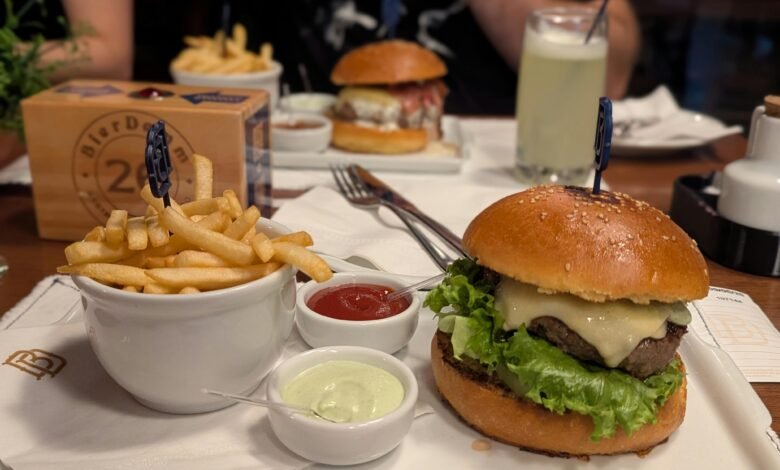Algerian Sauce: Recipe, Taste, and Everything You Need to Know

If you’ve ever had a kebab, burger, or wrap and wondered what that creamy, slightly spicy sauce was that made it so addictive, chances are—it was Algerian Sauce. This North African-inspired condiment has quietly taken over kitchens and fast-food counters around the world, especially in Europe.
In this article, I’ll walk you through everything about Algerian sauce—its taste, ingredients, uses, how to make it at home, and even how it fits into different cuisines. I’ll also share a few personal opinions and experiences that might inspire you to try it today.
What Is Algerian Sauce?
Algerian sauce is a creamy, tangy, and slightly spicy condiment that originates from North African flavors, particularly inspired by Algeria. It’s known for its balance of sweetness, spice, and creaminess—a flavor combination that works beautifully with grilled meats, fries, and sandwiches.
Unlike mayonnaise or ketchup, Algerian sauce has a unique personality. It blends chili, garlic, mustard, tomato, and creamy mayo to create something truly special.
When I first tried it at a small kebab shop in London, I couldn’t believe how perfectly it complemented the crispy fries and tender chicken. It wasn’t too spicy, just warm enough to tickle your taste buds.
A Short History of Algerian Sauce
While the exact origin of Algerian sauce is not fully documented, it’s widely believed to have been inspired by Algerian street food traditions that emphasize bold and flavorful sauces. The modern version we see today became popular in Europe, particularly in France and Belgium, through North African immigrant communities.
In these regions, Algerian sauce became a staple in kebab shops, often served alongside garlic sauce, harissa, and white mayonnaise. Over time, it spread across the world and is now found in supermarkets and fast-food outlets under various brand names.
What Does Algerian Sauce Taste Like?
The taste of Algerian sauce can be described as:
-
Creamy – thanks to the mayonnaise base.
-
Tangy – from vinegar and tomato puree.
-
Spicy – from chili or cayenne pepper.
-
Sweet – with hints of sugar or sweet paprika.
When you take a bite, you’ll first notice the smooth creaminess, followed by a tangy sweetness, and finally a mild spicy kick that lingers pleasantly.
It’s not overwhelming like hot sauce—it’s more of a gentle warmth, perfect for people who like mild spice.
Main Ingredients of Algerian Sauce
Most Algerian sauce recipes use a few core ingredients, but proportions and brands can vary slightly. Here’s what goes into it:
-
Mayonnaise – for the creamy texture.
-
Tomato paste or ketchup – for color and tang.
-
Chili powder or harissa – for spice.
-
Garlic – to deepen the flavor.
-
Mustard – for sharpness and balance.
-
Paprika – for color and a hint of sweetness.
-
Vinegar or lemon juice – for acidity.
-
Sugar or honey – to balance the heat.
Some people also add pickle juice or onions to give it a little crunch and character.
How to Make Algerian Sauce at Home
Here’s a simple recipe that you can try in your own kitchen. I’ve made this many times, and it’s as close to the restaurant-style version as it gets.
Ingredients:
-
1 cup mayonnaise
-
1 tablespoon ketchup
-
1 teaspoon Dijon mustard
-
1 teaspoon chili sauce or harissa
-
1 teaspoon lemon juice or vinegar
-
1 clove garlic (minced)
-
1 teaspoon paprika
-
½ teaspoon sugar
-
Salt to taste
Instructions:
-
Add all the ingredients into a bowl.
-
Mix thoroughly until the sauce is smooth.
-
Taste and adjust—if you like it spicier, add more chili; for more sweetness, a bit of honey does the trick.
-
Chill in the fridge for at least 30 minutes before serving.
This helps the flavors blend perfectly. I usually prepare it in advance when I’m having a barbecue—it tastes amazing with grilled chicken and even roasted potatoes.
Popular Ways to Use Algerian Sauce
One of the reasons this sauce is loved by so many is its versatility. Here are a few ways to use it:
1. With Fries
Dip your crispy fries in Algerian sauce instead of ketchup. The flavor is far richer and more satisfying.
2. In Burgers and Wraps
Spread it inside your burger or wrap for a creamy, tangy punch that complements both chicken and beef.
3. With Grilled Meats
Whether it’s barbecue, kebabs, or roasted vegetables, Algerian sauce adds depth to any smoky dish.
4. As a Salad Dressing
Mix it with a little yogurt or lemon juice to make a delicious dressing for spicy salads.
5. For Dipping
It pairs beautifully with nuggets, onion rings, or even breadsticks.
Nutritional Information
While delicious, Algerian sauce is still a condiment—so moderation is key.
Approximate Nutrition per tablespoon:
-
Calories: 90
-
Fat: 9g
-
Carbohydrates: 2g
-
Protein: 0.3g
To make it healthier, you can use low-fat mayonnaise or Greek yogurt instead of full-fat mayo.
Store-Bought vs. Homemade Algerian Sauce
If you’re in a hurry, many supermarkets sell bottled Algerian sauce. Popular brands offer slightly different tastes—some are creamier, while others are spicier.
However, I always prefer homemade because you control the ingredients. Store-bought versions may contain preservatives or artificial flavors, while your homemade version will taste fresher and more authentic.
The Cultural Influence of Algerian Sauce
Algerian sauce is more than just a condiment—it’s a small window into North African food culture. It reflects the balance of spice, sweetness, and depth that’s common in Algerian cuisine.
Food has always been a way for cultures to connect. Through dishes like this, people around the world get to experience flavors from Algeria without ever visiting. That’s the beauty of culinary globalization—it brings us closer through taste.
My Personal Experience with Algerian Sauce
I first discovered Algerian sauce at a late-night kebab shop in Paris. The vendor recommended it instead of mayonnaise, saying, “Try this—you’ll never go back.”
He was right. The moment I dipped my fries in that orange-gold sauce, I was hooked. Since then, I’ve tried making it at home many times. It’s now a must-have at every family barbecue.
There’s something special about it—familiar yet exotic, creamy yet fiery. It’s comfort and adventure in one bite.
How to Store Algerian Sauce
You can store homemade Algerian sauce in an airtight jar in the refrigerator for up to one week. Always use a clean spoon to avoid contamination.
If you’ve made a big batch, don’t freeze it—the mayonnaise base can separate after thawing. It’s best enjoyed fresh.
Conclusion
Algerian sauce is one of those magical condiments that turns ordinary food into something extraordinary. Its balance of creamy, spicy, and tangy flavors makes it perfect for everything—from fries and burgers to kebabs and grilled vegetables.
Whether you buy it or make it yourself, Algerian sauce deserves a spot in your kitchen. It’s proof that great taste often comes from simple ingredients and cultural blending.
Frequently Asked Questions (FAQs)
Q1: What is Algerian sauce made of?
It’s made from mayonnaise, tomato paste, chili, mustard, garlic, and spices.
Q2: Is Algerian sauce spicy?
It’s mildly spicy—more flavorful than fiery, perfect for those who don’t like extreme heat.
Q3: Can I make Algerian sauce vegan?
Yes! Use vegan mayonnaise and skip any animal-based ingredients.
Q4: How long does Algerian sauce last in the fridge?
About 5–7 days in an airtight container.
Q5: What foods taste best with Algerian sauce?
Fries, burgers, grilled chicken, wraps, kebabs, and even roasted vegetables.

